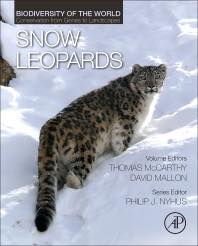We contributed to the book on Snow Leopards, published by Elsevier on 24th June 2016 Series Editor: Philip Nyhus Series Volume Editors: Tom McCarthy David Mallon
Snow Leopards: Biodiversity of the World: Conservation from Genes to Landscapes is the only comprehensive work on the biology, behavior, and conservation status of the snow leopard, a species that has long been one of the least studied, and hence poorly understood, of the large cats.
Breakthroughs in technologies and methodologies to study this elusive cat have come rapidly, including non-invasive genetics, camera traps, and GPS-satellite collaring. The book begins with chapters on the genetic standing and taxonomy of the snow leopard, followed by chapters on their behavior and ecology. Additional contributions follow on the current and emerging threats to the species, which include longstanding concerns, such as poaching and conflicts with livestock, and new and emerging threats such as mining and climate change.
A section on conservation solutions, backed by valuable case studies, starts with an overview of the important role mountain communities play in assuring the snow leopard’s long-term persistence. In addition, chapters on the role of captive snow leopards for the conservation of the species, state-of-the-art techniques and technologies for studying and monitoring snow leopards, status reports from around the region, and future perspectives, such as transboundary conservation initiatives, international conventions (CITES, CMS, etc.), the role of the IUCN Cat Specialist Group and the Snow Leopard Network, and undertakings such as the Global Snow Leopard Forum facilitated by the World Bank are also included.

